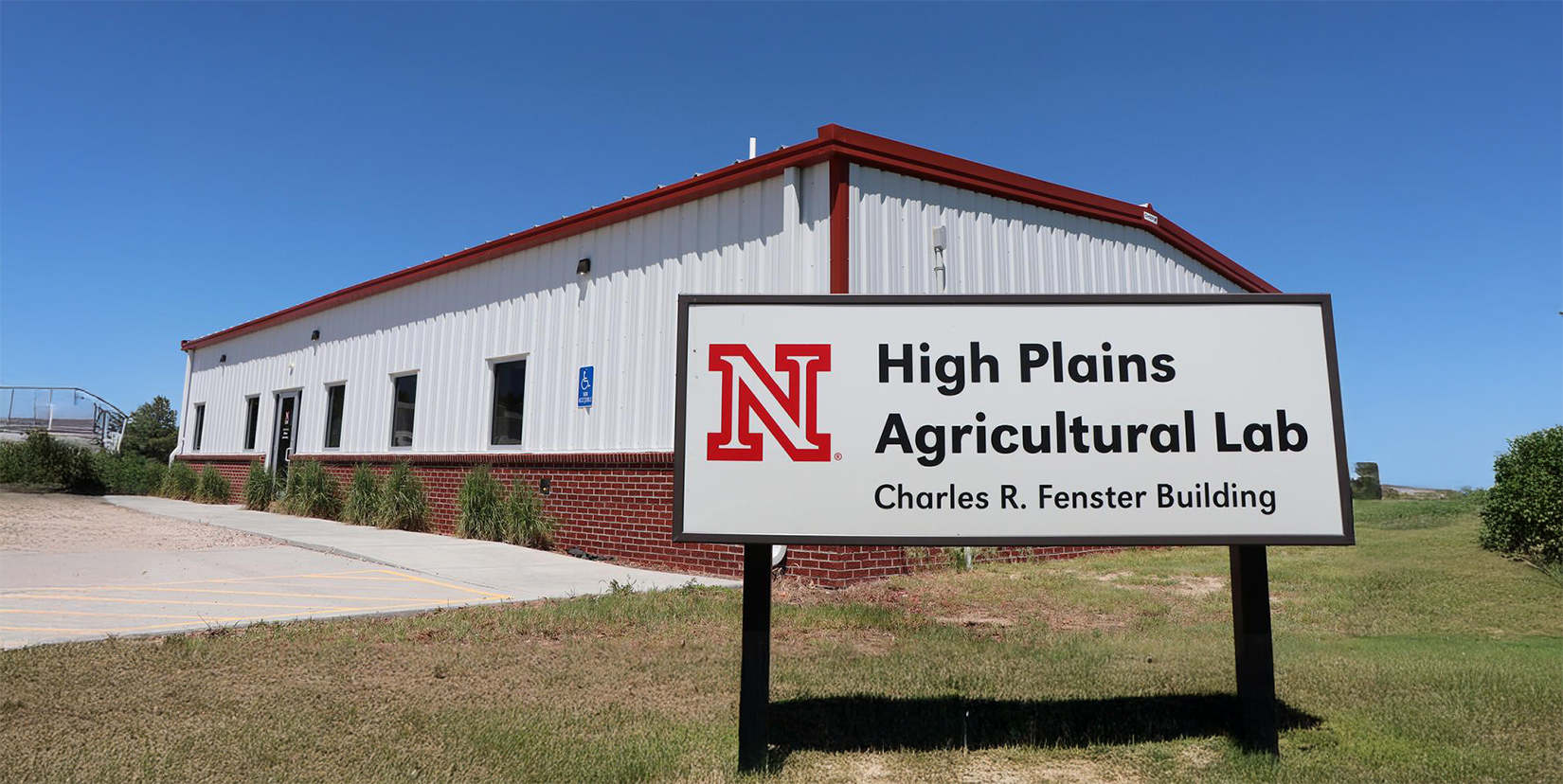HPAL Mission:
The High Plains Ag Lab (HPAL) is a satellite unit of the Panhandle Research and Extension Center in Scottsbluff. Our mission is to improve the profitability of dryland crop and livestock production through applied research responsive to the needs of local producers. HPAL covers 2,400 acres, one-third in dryland crop rotations and two-thirds in pasture.
The HPAL building was named after Charles Fenster for his contributions to agriculture and conservation. The 2,800-square-foot building provides offices for permanent staff; work stations for students or visiting scientists; a conference room; and space for seed and plant material handling
Locate HPAL:
- Address: 3257 RD 109, Sidney, NE 69162.
- Phone: 308-254-3918
- Directions: Six miles north of Sidney, NE, on Highway 385, then west on County Road 32 (see map) In the heart of western Nebraska's major dryland crop production area.
Expertise
Fifty to 60 research trials are conducted each year by scientists based at the Panhandle Research and Extension Center as well as University of Nebraska-Lincoln and neighboring states. Expertise includes agronomy; plant breeding, physiology, and pathology; soil fertility; irrigation; entomology; weed science; marketing and economics; and livestock nutrition.
Crop Research
Crop rotation systems: Research crops are produced on 27 fields ranging in size from 22 to 36 acres. View a 2009 map of research plots. Seven different crop rotations range in length from two to six years. Various cropping system components are represented: summer fallow, no-fallow, minimum tillage and no-tillage. These systems allow research with the same crops and rotations used by our clientele. In 2006, 75 acres were certified for organic production.
Irrigated plots: A 15-acre, lateral-move irrigation system enables scientists to simulate different precipitation patterns.
Long-Term Tillage Plots: Established in 1970 to compare moldboard plow, sub-tillage, and no-tillage fallow systems on winter wheat and soil parameters. A native sod treatment has been maintained.
Grain dryer and storage: A continuous flow dryer and grain storage system allow direct harvest of proso millet and emerging alternative crops with a stripper header.
Livestock Research
Nine pastures: Cattle graze crested wheatgrass pastures to assess supplementation, feed additives or health measurements on performance.
PANHANDLE PERSPECTIVES - High Plains Ag Lab is 50 years old
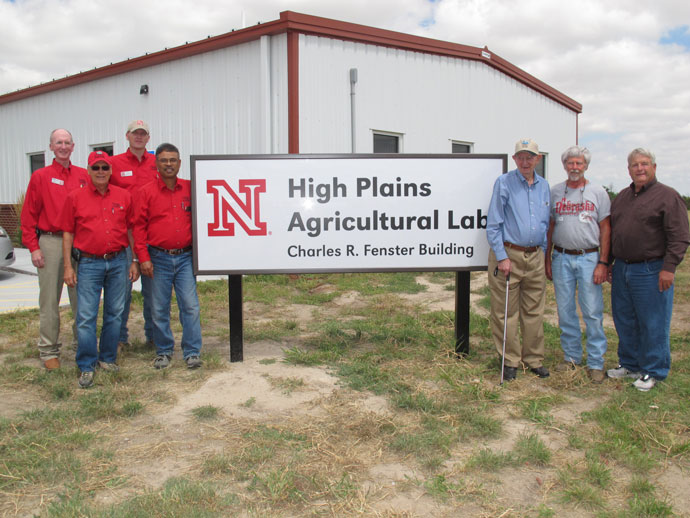
By Dave Ostdiek, Communications Associate, UNL Panhandle Research and Extension Center
As the new year begins, the research plots are quiet at the High Plains Ag Laboratory 6 miles northwest of Sidney. Winter wheat fields are dormant and summer crop fields are awaiting the spring planting season.
But inside, scientists and support staff are analyzing data, planning for 2021, and doing the other tasks of carrying out research that is aimed at helping crop and livestock producers in this semi-arid region be more efficient, sustainable and profitable.
The High Plains Ag Lab (HPAL) is operated by the University of Nebraska-Lincoln Institute of Agriculture and Natural Resources (IANR), under the supervision of IANR’s Panhandle Research and Extension Center at Scottsbluff, 75 miles to the northwest.
It was 50 years ago last August that the U.S. Department of Defense deeded more than 2,000 acres of land, previously part of a military munitions depot, to the University of Nebraska to use for research. Since then, HPAL has helped bring about some notable advances in crop and livestock production. It enters its sixth decade with improved and expanded facilities, equipment and capacity, and a new role as the base camp for the Nebraska Variety Testing Program.
HPAL’s 2,410 acres consist of working laboratories for both crops and livestock research: 710 acres for crops, divided into 17 fields, and the remaining approximately 1,700 acres for grazing land, divided into 12 pastures. Two of the crop fields are equipped with lateral-move sprinkler systems to simulate rain.
A new office-research building was constructed in 2015. Other buildings include a large shop, and several other buildings that remained from HPAL’s previous life as a military ordnance depot.
The 50th anniversary normally would have been observed during a summer annual field day. But the COVID pandemic intervened to change things in 2020. Instead of hosting group tours of the plots HPAL held virtual tours.
Research at HPAL is supervised by Cody Creech, Dryland Cropping Systems Specialist, who is based at the Panhandle Center in Scottsbluff. The Sidney staff includes Farm Manager Jake Hansen, Research Assistant Professor Amanda Easterly, and research technicians Vern Florke, Bill Struckmeyer, Stephan Geu, and David Blanke, along with several graduate students.
Other UNL faculty based at the Panhandle Center also conduct research at HPAL in disciplines including soil science, nutrient management, plant breeding, plant pathology, entomology, weed science, economics, forage and range management, and yearling stocker grazing systems.
The locally based faculty and staff conduct research in collaboration with Lincoln-based IANR faculty, researchers from other universities, and researchers from the U.S. Department of Agriculture’s Agricultural Research Service (USDA-ARS). Strategic direction is provided the HPAL Advisory Committee of local stakeholders, chaired by Keith Rexroth, a Sidney farmer.
The office and laboratory building dedicated in 2015 is named for Charles R. Fenster of Gering, in recognition of Fenster's lifetime work as a pioneering UNL cropping systems specialist. Fenster, who retired in 1982 and passed away in 2016, was the first faculty supervisor at HPAL and was instrumental in its establishment.
The 2,800-square-foot building provides offices for permanent staff; work stations for students or visiting scientists; a conference room; and space for processing and analyzing seed and plant material.
In 2019 HPAL became the new home of the Nebraska State Variety Testing Program, led by Creech and Easterly, whose goals are to develop the program into a leader regionally and to leverage new research opportunities. The program includes not only winter wheat, but also spring wheat, corn, and grain sorghum. And additional crops will follow in 2021.
New equipment and technology acquired in recent years will help carry out the variety trials program. A new plot combine makes harvesting quicker, improves data collection, and provides in-cab sampling. HPAL also has new equipment and technology to allow the use of barcodes to streamline data capture, and equipment to test the protein content of grain in-house. The staff constructed a new research drill for planting wheat in 2020. The new implement allows for precision application of seed and fertilizer and is fitted with Global Positioning System.
Although the university formally acquired HPAL in 1970, the groundwork had been laid nearly a decade earlier by a group of area ag and business leaders who saw the need for a research facility that could address the problems specific to the High Plains. Sidney is not only 350 miles west of UNL’s main campus in Lincoln. It is also about 3,500 feet higher in elevation and receives about half the annual average precipitation.
The locally based effort that recognized the need and lobbied the University of Nebraska, Nebraska State Legislature, and Department of Defense for support, funding, and the needed land is described in “College of Agriculture of the University of Nebraska Lincoln: The First Century,” a book by Elvin Frolik and Ralston J. Graham published in 1987.
As Frolik and Graham tell it, the work of the Cheyenne County Rural Area Development (RAD) Committee, largely through its crops committee, was instrumental in getting the Laboratory established. The need for the field laboratory was underscored in 1964, when there was a severe outbreak of black stem rust, wheat streak mosaic, and crown and root rot of wheat in the Panhandle. That year it was announced that the Department of Defense was phasing out the Sioux Army Ordnance Depot. The RAD Committee immediately explored the possibility of utilizing some of the land and facilities for an experiment station.
The ordnance depot was established during World War II, in 1942, according to a nearby highway marker erected by the Nebraska State Historical Society. The depot’s mission was the receipt, storage, and issue of all types of ammunition from small arms to 10,000-pound bombs, all types of general supplies from small automobile parts to jeeps, and various strategic and critical materials. The depot was a vast facility, occupying 19,771 acres with 801 ammunition storage igloos, 22 general supply warehouses, 392 support buildings, 225 family living quarters, 51 miles of railroad tracks, and 203 miles of roads. It was deactivated in 1967.
Beginning in 1962, representatives of the RAD committee, along with Extension staff and State Sen. George Fleming, made trips to Lincoln to seek support in establishing a field research laboratory from UNL administration (including Frolik, then University of Nebraska Dean of Agriculture).
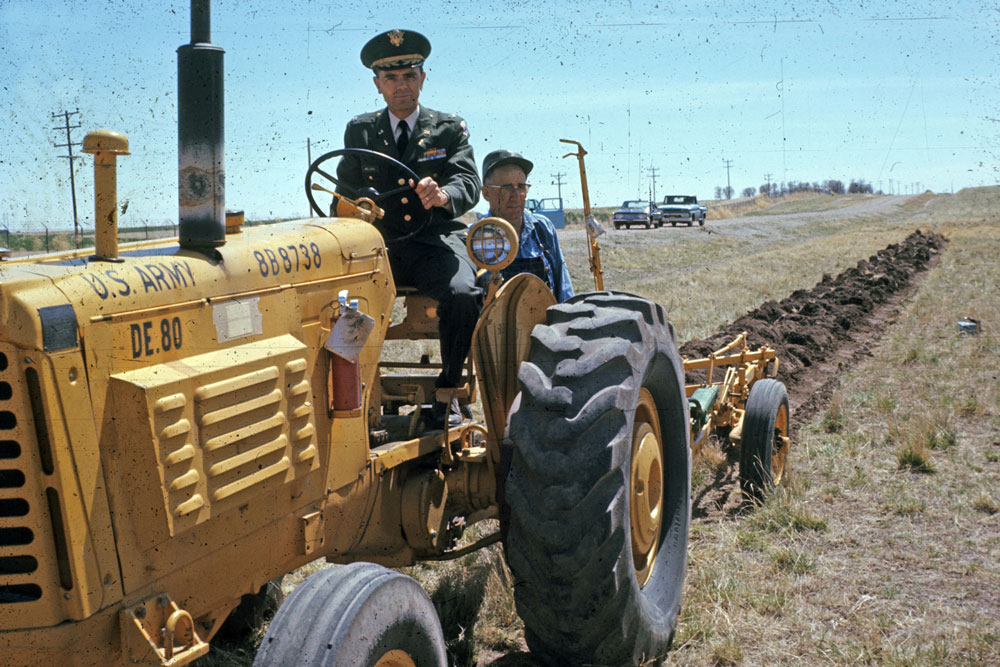
Over the next several years, the Sidney delegation conducted shuttle diplomacy, meeting with UNL administrators, state officials and U.S. Department of Defense brass to provide evidence of the need for an ag lab, arrange to transfer ownership of part of the ordnance depot and convert it to the new use, and provide the funding and other support needed to establish and operate the lab.
In 1965 the Legislature approved a bill to establish the experiment station and appropriated $100,000 in funding. In 1966, the University of Nebraska Board of Regents applied to the U.S. Government for a transfer of land, improvements and equipment. After lengthy negotiations, the government issued an interim use permit for the University to initiate operations. On April 7, 1967, the U.S. Government made available to the University of Nebraska 2,410 acres of land along with 14 round igloos, two warehouse buildings, and one headquarters building, as well as farm equipment, industrial equipment, and tools.
In 1970 the federal government deeded the land to the university.
Under Fenster's guidance a research program was initiated immediately upon the university's obtaining possession of the property. In addition to Fenster, subsequent faculty supervisors have included David Baltensperger, Drew Lyon, and Cody Creech. When the RAD Committee was terminated in 1971, Director John L. Weihing of the Panhandle Station prevailed upon the members to become the advisory group for the HPAL.
UNL provides the facilities, faculty, staff and equipment to conduct research at HPAL along with support from commodity groups, industry, and others.
During a given year, crop research at HPAL consists of 25 or more trials, with the primary focus on key regional production issues: integrated management of weeds, diseases and pests in winter wheat and sunflower. The fields allow for eight different crop rotations ranging from two to six years, representing the rotations commonly used in region. Long-term tillage plots established in 1969 compare moldboard plow, sub-tillage, and no-tillage fallow systems.
HPAL also is a key location for grazing supplementation research. A main focus is integrated crops and livestock systems (especially ways of improving cattle performance with supplements to cool-season grasses, which have less nutrition value late in the summer). Potential strategies include feeding cattle on field peas, planting annual forages in various points in a rotation (replacing dryland crop or fallow, or following a dryland crop). Another livestock research focus is strategic supplementation and marketing strategies for yearlings on grass.
Over the years, HPAL has played a major role in developing dryland tillage systems such as eco-fallow, stubble mulch, and flexible fallow. Other notable research to come out of the Sidney facility over the past 50 years includes:
- Breeding nurseries for winter wheat, millet, sorghum
- Control of Russian wheat aphid, sunflower insect pests, wheat stem sawfly, wheat curl mite
- Crop rotations for control of jointed goatgrass, rye, and downy brome
- Optimum rotations for dryland crops including wheat, proso millet, corn, forages
- Nutritional supplements for cattle on summer range
- Cattle production systems from weaning to slaughter, and use of locally grown feedstuffs for supplementation.
Remembering Charlie Fenster
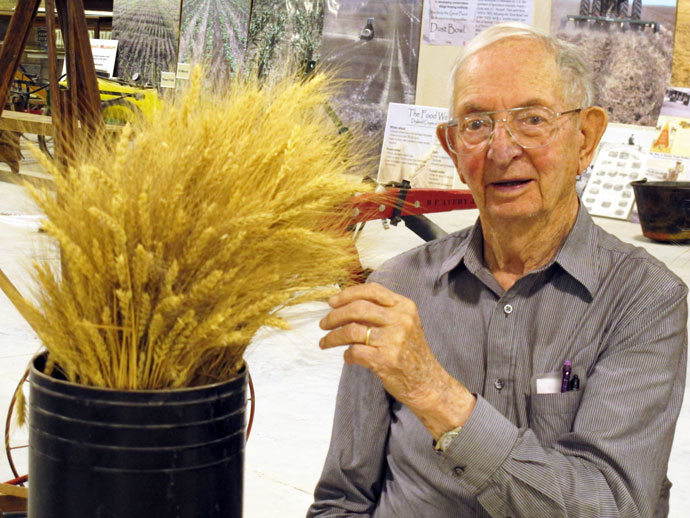
By David Ostdiek, Communications/Technology Specialist
Note: We at the Panhandle Research and Extension Center received word of the passing of our friend and colleague Charles R. Fenster on Feb. 10, 2016. This profile of Charlie was published in 2015, when the new building at UNL's High Plains Ag Laboratory near Sidney was named for the retired dryland cropping specialist in recognition of his achievements and contributions.
The personal history of Charles R. Fenster, "Charlie" to anyone who has ever met him, will always be intertwined with that of the University of Nebraska-Lincoln's High Plains Agricultural Laboratory (HPAL) north of Sidney.
Fenster, 96, was a dryland cropping systems specialist for UNL at the Panhandle Research and Extension Center from 1956 until retiring in 1982. He was faculty supervisor at HPAL from its establishment in 1970 until he retired 13 years later.
Fenster's contributions received permanent formal recognition in August 2015 during the annual High Plains Ag Lab Field Day, when a new building completed in 2014 was named for him.
Although he's been retired for more than 30 years, Fenster remained active nearly to the end of his life. As recently as 2015, on most days he could be found at the Legacy of the Plains Museum in Gering, where one of the exhibits tells the story of the development of conservation tillage in dryland farming - a story in which he played a big role. He also attended field days and similar events.
Fenster's research at HPAL on dryland farming practices has had a widespread and lasting impact on wheat yields, soil and water conservation, and profitability. It has helped transform the way dryland farmers raise crops in the High Plains, from the original wheat-black fallow rotation, which was associated with dust storms and several wind erosion, into the more productive, sustainable conservation tillage systems used today.
He worked cooperatively with colleagues from the home campus of UNL's Institute of Agriculture and Natural Resources (IANR) in Lincoln, as well as from the U.S. Department of Agriculture Agricultural Research Service (ARS) and other land-grant universities.
A Chappell native, Fenster taught vocational agriculture before going to work for the USDA Soil Conservation Service (later to be renamed Natural Resources Conservation Service). Working in Pierce County with demonstrations of Dr. F.L. Duley and Prof. J.C. Russel of the university, he learned that stubble mulch tillage methods could help manage sandy soils.
He accepted a university assignment in 1956 to address soil and water management problems of dryland farming in the Panhandle. He operated first from the Box Butte Station at Alliance (since closed), then the Scottsbluff Station at Mitchell, and finally at the Panhandle Research and Extension Center at Scottsbluff. Wheat farmers came to regard Fenster as the authority in dryland crop and soil management.
In 1966 Fenster became a full professor and extension agronomist, one of few to earn the academic rank without a doctorate degree. As he tells it, administrators felt at the time felt it was important to keep him at work in the field instead of taking courses on campus in Lincoln.
UNL dedicated the High Plains Ag Lab in 1970. But acquisition of the land and facilities was preceded by years of efforts by local individuals and groups, state government, and the U.S. Army.
An instrumental local group was the Cheyenne County Rural Area Development (RAD) Committee, especially its crops committee. Committee members, County Agent Ivan Liljegren, and State Sen. George Fleming traveled to Lincoln in 1962 to seek Ag College Dean Elvin Frolik's support for establishment of a field research laboratory. That June a delegation from East Campus, including Frolik and Herbert Kramer, director of state experiment stations for the university, toured the Sioux Army Depot several miles north of Sidney as a possible site.
The Sioux Army Depot operated from 1942 until 1967. Its mission was receiving, storing, and issuing all types of ammunition, general supplies, and materials.
When the Defense Department had announced that the depot would close, UNL and the local delegation intensified efforts to determine its suitability for a research station. Fenster created a soils map with help from the USDA Soil Conservation Service, and decided that the site was ideal. Soils at HPAL are representative of much of the High Plains of western Nebraska, he said.
The Nebraska Legislature appropriated money, the NU Board of Regents formally applied for the lands and building, and the U.S. Government made the land available. The deed and permit to initiate applications came in 1970.
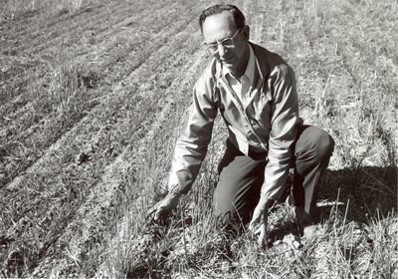
UNL received 2,400 acres of land (one-third in dryland crops and two-thirds in pasture); 14 ammunition storage igloos, each 50 feet in diameter, made of reinforced concrete and covered with 3 feet of soil; two warehouse buildings; and the 42- by 114-foot headquarter building.
The HPAL research program always emphasized efficient use of soil and water and optimizing crop yields under the semi-arid conditions of the High Plains. Fenster worked with a local advisory committee that had been created from the RAD Committee.
Scientists from a range of disciplines collaborate at HPAL, including agronomy; plant breeding, physiology, and pathology; soil fertility; irrigation; entomology; weed science; marketing and economics; and livestock nutrition.
The headquarters building was instrumental in attracting researchers from the Lincoln campus and from USDA ARS to the facility, according to Fenster. And many graduate students have worked at HPAL over the years. He said the old building has served its purpose well, but was designed for a different use and cannot meet all the needs of a collaborative research facility.
The new building serves as headquarters for dryland research and extension work, but also will facilitate enhanced work with ag industries.
HPAL will be important to future research, Fenster said in a 2015 interview. He said agricultural production will be shaped by technology such as GMOs (genetically modified organisms), GPS (geographic positioning systems) and other advances.
"It might be a blessing to UNL to have this facility for potential new research to be developed," Fenster said. "If it enhances dryland work on behalf of the university in western Nebraska, go for it. The bottom line: I'd like to see it enhance the agriculture of western Nebraska."
The HPAL research program has grown and expanded. Fifty to 60 research trials are conducted each year on 27 fields ranging in size from 22 to 36 acres. Seven different crop rotations range in length from two to six years. Various cropping systems are represented, such as summer fallow, no-fallow, minimum tillage and no-tillage, to simulate the methods used by farmers in the area. In 2006, 75 acres were certified for organic production.
A 15-acre, lateral-move irrigation system enables scientists to simulate different precipitation patterns. Recent improvements in equipment include a continuous flow dryer and grain storage system that allow direct harvest of proso millet and emerging alternative crops with a stripper header.
As a satellite unit of the Panhandle Research and Extension Center at Scottsbluff, HPAL is under the leadership of Panhandle Research and Extension's Director. A faculty supervisor oversees operations at the ag lab, and the staff includes a farm manager, technicians, and graduate students. The HPAL Advisory Board provides input on research priorities.
Perhaps the biggest impact of HPAL, according to Fenster, has been the information gathered from a long-term soil management study established in 1970, overseen by Fenster and Gary Peterson, now-retired soil scientist from Colorado State University. Peterson is professor emeritus and former department head of Plant Sciences at CSU. The long-term plots compare winter wheat and soil parameters (such as the fate of nitrogen) in a variety of tillage settings, including moldboard plow, sub-tillage, and no-tillage fallow systems.
A native sod treatment has been maintained.
The long-term study has yielded a bumper crop of data. Since 1985, there have been more than 45 refereed journal papers, a number of book chapters, proceedings, and a number of graduate theses. In all, Fenster says, there have been more than 100 published pieces.
Following retirement Fenster had remained active in Nebraska agricultural circles. He lived in Gering and held the title of professor emeritus at the Panhandle Center. Charlie and his wife Eunice, who preceded him in death, also were major contributors to the university. He volunteered for the University of Nebraska Foundation and the University of Nebraska Alumni Association. He had been involved in the Farm and Ranch Museum (now Legacy of the Plains Museum) in Gering since its inception.
He was inducted into the Nebraska Hall of Agricultural Achievement in 1983, and in 1991 was recognized as an honoree for the Nebraska Hall of Agricultural Achievement. In 2000 he was recognized as an honoree for the Nebraska Agribusiness Club Public's Service to Agriculture Award. He was the 2008 recipient of the Outstanding Service to Panhandle Agriculture Award.
In 2005 the Fensters endowed a major gift to establish an endowed professorship at the Panhandle Center, the Charles R. and Eunice R. Fenster Professorship Fund at the University of Nebraska Foundation.
